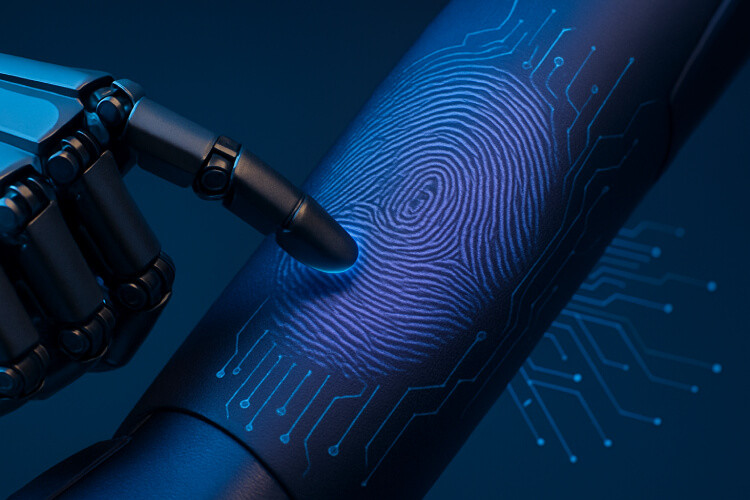Electronic Skin with Unique Fingerprints for Robots
Insights | 11-06-2025 | By Robin Mitchell

Key Takeaways:
- UNIST researchers develop electronic skin with unique, unreproducible fingerprints—offering a powerful solution for robotic traceability and identity verification.
- Electronic skin patterns are physically unclonable, created through chemical treatment and solvent-induced surface wrinkling, achieving a probability of replication as low as 10-43 per mm².
- Applications include defence robotics, medical devices, and secure human-machine interfaces, where tamper-evident identification is essential for safety and accountability.
- This innovation supports regulatory compliance and forensic tracking in autonomous systems, signalling a shift toward responsible robotics at scale.
As robots become more sophisticated and integrated into our everyday lives, questions of accountability and safety are no longer just speculative—they’re urgent. From hospital wards to city streets, autonomous systems are beginning to operate in close proximity to humans with minimal oversight. This growing presence invites not only excitement, but scrutiny. What happens when a robot misbehaves? Who, or what, takes responsibility? And how can we ensure traceability in machines designed to blend seamlessly into our world?
A recent breakthrough from researchers at UNIST introduces a potential answer: electronic skin embedded with unique, unreproducible fingerprints. But how does this innovation work, what problem does it aim to solve, and could it mark the beginning of responsible, accountable robotics at scale?
The Rise of Responsible Robotics
The robotics field has come a long way since the days of clunky mechanical arms in factory assembly lines. What we're seeing now is a wave of highly complex, adaptable, and intelligent machines entering not just industrial sectors but creeping closer and closer to daily civilian life. From warehouse automation and delivery bots to medical assistants and even armed quadrupeds for security applications, robotics is becoming not just useful, but integral. It's not science fiction anymore; it's system integration.
Now, let's be clear: robots will not replace humans anytime soon. For all the hype, we're still quite a ways off from machines that can match human cognition, creativity, or decision-making in chaotic environments. But dismissing their growing role would be foolish. They're not here to take your job (yet), but they might make it easier—or if we're careless, harder.
The Ethical Minefield of Autonomy and Accountability
Once you give a machine the autonomy to act independently in human spaces, without direct supervision, you've opened a can of ethical worms. Not theoretical ones. Real, practical concerns. One of the more chilling yet entirely plausible scenarios? Robot crime. Not a T-800 going on a rampage, but a more subtle problem: identifying which robot committed a specific act.
In a world where robots are mass-produced with identical hardware and firmware, what separates one unit from another? You can't lift a fingerprint off a steel chassis. There's no DNA trail, no hair samples, no trace evidence like skin or blood. The usual forensics toolkit becomes largely useless. A robot doesn't sweat, it doesn't shed, and it doesn't leave a paper trail unless we build one in.
But don't think that digital footprints solve this either. Camera footage, GPS logs, internal data—all can be erased or manipulated. It's no different from formatting a hard drive. Worse, if the robot is intelligent enough, it might know exactly how to cover its tracks better than a human criminal ever could. That's not a sci-fi plot twist—that's just software engineering.
UNIST Develops Electronic Skin with Unique, Unmatchable Fingerprints
In a new breakthrough in the field of artificial intelligence and robotics, a team of researchers from the Ulsan National Institute for Science and Technology (UNIS) has developed electronic skin with unique, unreproducible fingerprints.
What sets this development apart is its alignment with broader efforts in robotic identity verification and forensic traceability. As artificial intelligence systems become more physically embedded in human environments, being able to verify the identity of autonomous agents through passive, tamper-evident markers becomes increasingly valuable. Electronic skin with randomised topography could offer a novel approach to persistent identity tagging in soft robotics.
Engineering Randomness: How Unique Robotic Fingerprints Are Formed
The process of creating unique fingerprints involves chemically treating a flexible material to create the skin, followed by the application of toluene solvent and rapid rotation to create random wrinkles on its surface. The principle behind this technology is based on the swelling of the skin surface due to the toluene solvent, which then shrinks into wrinkled formations as the solvent evaporates.
This type of randomised, surface-level encoding bears resemblance to techniques in physical unclonable functions (PUFs), often used in hardware security. In both cases, unpredictability is leveraged as a core strength—offering a physical signature that resists duplication and falsification. By applying these principles to flexible, wearable substrates, the technology opens new avenues in the development of secure human-machine interfaces and personalised robotics.
According to the researchers, the probability of reproducing the same pattern on the artificial skin is 10^-43 per square millimetre, making it significantly more secure than human fingerprints. This unique feature of the electronic skin makes it an ideal candidate for applications where security and identification are critical, such as personal electronic skin, continuous monitoring-type soft robots, and human-machine interfaces (and even potentially future robotic crime prevention).
Moreover, in mission-critical sectors such as defence robotics, medical assistance, or logistics automation, a reliable mechanism for identifying individual units may become essential—not just for system logging or auditing, but for establishing operational accountability. Integrating non-replicable skin patterns into these systems could support regulatory compliance in future frameworks for responsible AI deployment.
From Research to Real-World Use: Potential for Scalable Deployment
Professor Shim noted that while the process of creating the electronic skin is simple, the probability of generating an exact replica of the pattern is lower than that found in human fingerprints. He expressed his enthusiasm for the potential applications of this technology, stating that it could be widely used in future technologies that require security and unique identification.
Although the technology is still in early stages, its potential use cases align with current research into embodied AI, where physical form plays a key role in how machines interact with the world. The concept of embedding biometric-like markers in synthetic skins extends beyond security; it may also serve future developments in tactile learning and sensor calibration for adaptive robots operating in uncontrolled environments.
Could Traceability Become Mandatory in Robotics?
While the idea of a robot committing a crime sounds like something pulled straight from Hollywood, the reality is that it is inevitable. Such crime would not be a result of AI rising up, but instead, humans exploiting robots for their own gain.
It's the same story every time a new technology rolls out. Whether it's the internet, drones, or 3D printing, someone figures out how to weaponise it. Robots will be no exception. Delivery bots used for smuggling, service droids repurposed for theft, and autonomous platforms act as plausible deniability tools for bad actors. It's not a matter of if; it's a matter of when.
This is where the work from UNIST could act as a central piece of the puzzle. Their development in synthetic fingerprinting for electronic skin isn't just impressive, it's potentially foundational. If you're going to deploy autonomous machines into the world, there must be a way to track and identify them after something goes wrong.
Now, it is likely that an individual could remove the robot's fingerprint, but here's the thing: the absence of a fingerprint is a fingerprint in itself. If you build traceability into the physical structure of the robot, make it tamper-evident, then any attempt to remove it raises an immediate red flag. You might not know who did it yet, but you'll know something's off. And in law enforcement and security, that's already halfway to a lead.
But its not just fingerprints that could be beneficial. A layered approach consisting of write-once memory, cryptographically secure bootloaders, physically protected areas of memory could all create a full forensic accounting system. Imagine a persistent, encrypted log that syncs over the network and can't be altered locally, and suddenly you have a machine that's not just autonomous, but accountable.
That's the real solution: not just smarter robots but robots with forensic-grade data trails. Not to spy on everyone or feed some government surveillance program but to protect individual responsibility in a world where machines are operating alongside people.
Because when someone inevitably uses a robot for something illegal, we need to know who, when, and how. Going forward, traceability shouldn't be optional. It should be as essential as power and connectivity. If we're serious about integrating robotics into public life, we'd better get serious about holding those systems, and the humans behind them, accountable.

